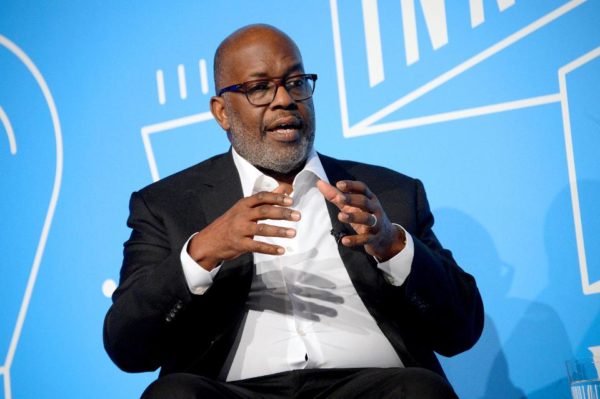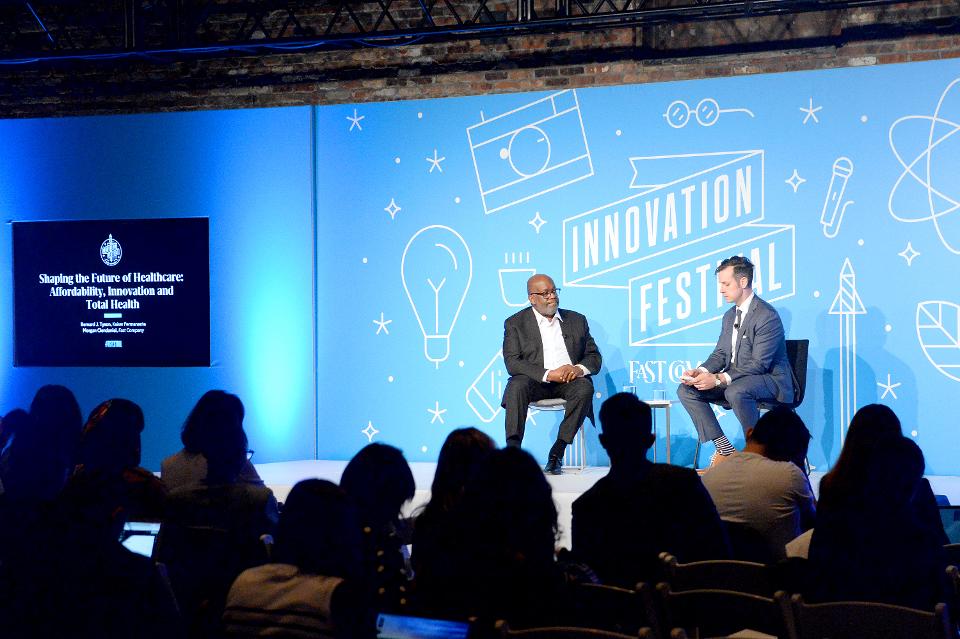

Just four days ago, Bernard J. Tyson spoke on stage at the “Shaping the Future of Health Care: … [+] Affordability, innovation and Total Health at the Fast Company Innovation Festival on November 06, 2019 in New York City. (Photo by Brad Barket/Getty Images for Fast Company)
Getty Images for Fast Company
In stunning news, healthcare lost a major leader today. Bernard J. Tyson, the Chairman and CEO of Kaiser Permanente, unexpectedly passed away in his sleep at just 60 years young.
Unexpected is an understatement since it was only yesterday when Tyson was a guest speaker at the AfroTech gathering in Oakland as shown by this tweet:
And three days prior, he had been in New York City to speak at the Fast Company Innovation Festival as seen in this picture:

Bernard J. Tyson and Morgan Clendaniel speak on stage on November 06, 2019 in New York City. (Photo … [+] by Brad Barket/Getty Images for Fast Company)
Getty Images for Fast Company
Discussing and advocating for key health issues was a big part of Tyson’s life. Through my career, I have met many hospital, health clinic, and insurance executives, and Tyson without a doubt has stood out from most of the rest. He was far from a “mind the store and pick up the paycheck” CEO. Sure, we can rattle off what happened to the typical metrics used to measure hospital and insurance CEO’s since he became Kaiser Permanente’s CEO in 2013 and it’s Chairman of the board of directors in 2014. Kaiser Permanente went from having 9.1 million members to 12.3 million, employing a workforce of 174,000 to 218,000, and generating $53 billion in annual revenues to $82.8 billion. These are all very impressive jumps but do not begin to capture the larger and what I think are the more important steps that have occurred.
Tyson has helped Kaiser Permanente become a leader in transforming how healthcare systems can have a greater impact on population health. Historically, many hospitals and much of the health care system in the U.S. have been way too focused on inpatient and “sick” care, because surprise, surprise, that’s where the immediate money seems to be. You can make a whole lot more money today trying to fix a medical problem (and even failing horribly to fix it) than preventing the problem in the first place.
This has made much of healthcare far too reactive, waiting for problems to occur, too focused on repairing people after they have already been broken. It’s like waiting at the of the wall for Humpty Dumpty to fall rather than helping him down from the wall or at least installing some seat belts. It can also be analogous to waiting for a car to fall into pieces before you take it (or rather carry it in a bag) to the shop and ask the mechanic, “hey, can you do something about patching everything together? I need to drive to a date tonight.”
Under Tyson’s leadership, Kaiser Permanente has taken major steps to expand the role of health care beyond the walls of hospitals and clinics. For example, as I reported previously for Forbes, there are the ongoing initiatives to address obesity and homelessness in the communities surrounding Kaiser facilities. Tyson covers the latter in this Kaiser Permanente video:
Another example is their first-of-its-kind partnership with the National Basketball Association (NBA) to tackle (or rather, since it’s basketball, assist with) children’s health issues, which I also have written about for Forbes.
Then there’s climate change, which for Pete’s and everyone else’s sake exists. Recognizing the impact that all of their facilities and many employees can have on pollution and the climate, Kaiser Permanente has been taking steps to become carbon neutral by 2020.
If this doesn’t sound like your typical hospital system or clinic, it isn’t. Tyson hasn’t been your typical healthcare system CEO either. When I spoke to Tyson earlier this year, the conversation was more about a vision of how healthcare should be and what a good healthcare system should be doing rather than a review of how great things already are. He didn’t dwell on dollar signs and listing the clinical services that Kaiser and its many physicians offer. Instead, he talked at length about how Kaiser was trying to not just be reactive but rather address the “social determinants of health” such as “improving basic infrastructure, promoting healthy eating, working on exercise, and taking care of the key ingredients to promoting health.” As he emphasized, “great health care is not just engaged with treatment.”
Tyson also pointed to a part of the body that healthcare systems frequently neglect. No, not the feet or the spleen. It’s the head or more specifically the mind, which incidentally should be connected to the rest of your body. As Tyson mentioned, Kaiser has been “extremely focused on the mind, as in mental health and well-being,” and “looking at the whole person.” He spoke of the “comprehensive package, looking at health and health care.” Again, while healthcare systems may talk about mental health and well-being, talk is cheap. They often don’t mind the gap or rather address the gap in taking care of the mind in the community. How many have actually invested in community well-being programs as Kaiser Permanente has?
Of course, Kaiser Permanente does have strong incentives to keep its millions upon millions of members healthy since it serves the dual purpose of insurer and healthcare system. However, this dual role alone may not necessarily lead to transformative change. When you talk to Tyson, you never got the sense that he was just spewing platitudes. Rather, expanding healthcare these directions seemed to be a passion.
For example, take a look at his experiences as a child. As he related to me, he was “greatly impacted by a wonderful mother, who was sick all of my life and wonderful doctor who take care of her and us.” This combined with the fact that his “father was a minister” meant that his “line of sight was always the community of the congregation. The community was the family.” He spoke of “having resources in the community and encouragement with multiple ‘moms’ who raised me as a child. The community came together,” and offered “a support system that you can rely on, that was in your corner,” that was encouraging, “you to be all that you can be.”
Certainly, Tyson was much more than the color of his skin. Nevertheless, in this day and age, color of the skin still unfortunately can be a major barrier in healthcare. It was an important step that Tyson, as a racial minority, became the leader of the largest nonprofit health plan and integrated delivery system in the United States. This brought a little more demographic diversity to healthcare leadership, which remains way too homogeneous. If you look at pictures of many healthcare system executives, the colors of the neckties are often more diverse that the colors of the skin. Tyson helped get many people more used to seeing an effective and forward-thinking healthcare system leader from a different background.
Here’s a tweet from NBA Hall of Famer Magic Johnson:
Tyson didn’t shy away from talking about how race, ethnicity, gender, and sexual orientation either. These demographic characteristics still unfortunately affect healthcare inside and outside hospital and clinic walls. In fact, he had strong interests in reducing disparities of care as well and said, “The fact that someone may not be getting what they should be getting because color of skin or sexual orientation is unacceptable. Period. No sentence to follow.”
The Kaiser Board of Directors has named Gregory A. Adams to fill Tyson’s shoes as Chairman and CEO on an interim basis. These are certainly big shoes to fill. Adams is no stranger to the Kaiser system as he had been reporting to Tyson as the Executive Vice President and Group President, overseeing all eight Kaiser Permanente Regions that includes 38 hospitals and 651 medical office facilities. Additionally, Adams has led Kaiser Permanente’s national Medicare care delivery strategy and was responsible for Kaiser Permanente’s partnership with the NBA. Adams appears in this video covering the launch of the NBA partnership:
Adams has been with Kasier Permanente since 1999, beginning at Kaiser Permanente in Southern California and subsequently holding positions with increasing leadership responsibility. Adams’ Kaiser Permanente biography includes more information on his background.
In a statement, Ed Pei, Kaiser Permanente board member and Chair of its Executive Committee and the Governance, Accountability and Nominating Committee, said: “Bernard was an exceptional colleague, a passionate leader, and an honorable man. We will greatly miss him. The board has full confidence in Greg Adams’ ability to lead Kaiser Permanente through this unexpected transition.”
Indeed, in his five years as CEO and over 30 years in the Kaiser system, Tyson made a major impact on healthcare that went well beyond hospital and clinic walls in many ways. Unfortunately, we won’t be able to see all that he could have done with more years at the helm.